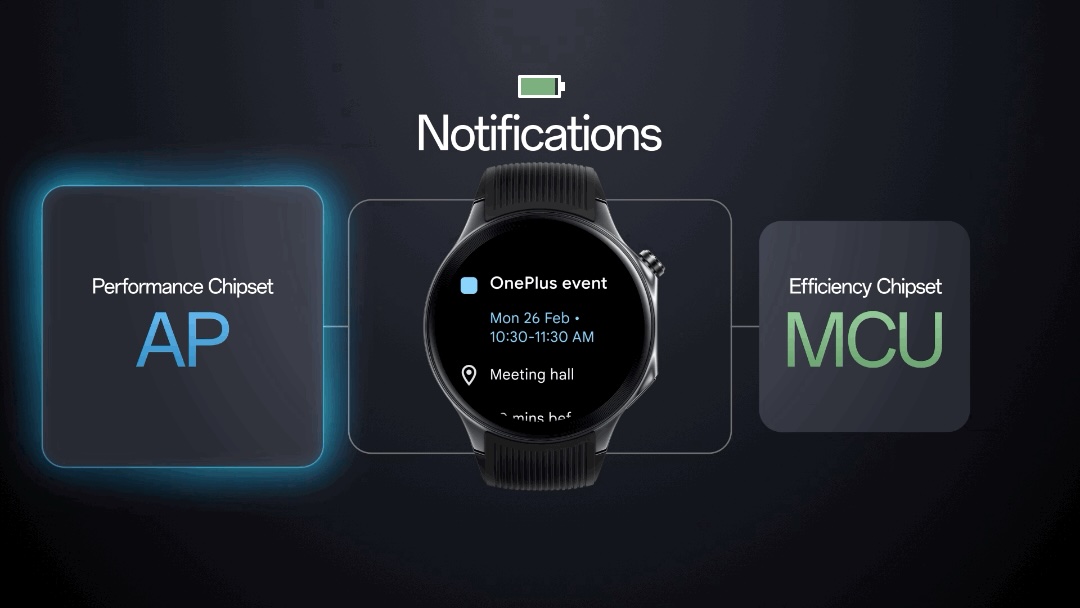
The OnePlus Watch 2 powered by Wear OS 4 touts “dramatically extended battery life of up to 100 hours of regular use with all functionalities accessible in Smart Mode.” This is due to the “substantially expanded” Wear OS hybrid interface, with Google touting how it has made “fundamental design changes to the platform” that improve performance and power.
In collaboration with our hardware partners, we’ve continued to prioritize the Wear OS by Google user experience.
In recent years, Wear OS watches have featured both an application processor (AP) and the low-power co-processor, or microcontroller unit (MCU), for what Google calls a “dual-chipset architecture.” The Wear OS hybrid interface intelligently switches between the chips “without jarring transitions between power modes.” Compared to past approaches, users don’t have to manually choose battery life or performance.

Increasingly, more operations can be handled on the co-processor, including “sensor data processing on the MCU while the AP is asleep.” Wear OS will not wake the AP until absolutely necessary in a big shift from invoking it every time you use the watch.
On the OnePlus Watch 2 and future Wear OS 4 watches that adopt this hybrid approach, the MCU can “process regular notification experiences and reduce the need to activate the AP,” which remains suspended. Bridged notifications from your phone are delivered to the watch “without waking up the high-performance AP.” You can read/expand and dismiss notifications using the co-processor, with the MCU also able to handle quick replies, remote actions, and other wearable-specific notification actions, like archiving.
Also of note is how you can view the watch face and swipe through Tiles on the MCU. Tapping a Tile or complication would open an Activity and seamlessly transition to the AP, while sending full notification replies will do the same.
In the example below, looking at a Calendar alert in the notification feed keeps you on the MCU. Tapping to open the full Google Calendar Wear OS app triggers the AP.
App developers have to just use the existing Wear OS APIs to benefit from the power savings and optimizations. This includes the Notification API and Health Services for “more precise workout tracking, automatic sports recognition and smarter health data monitoring.”
- “The notification hybrid interface enables seamless transitions between power modes to work with the Wear OS notification stack. You get the best notification performance by using the Notification API.”
- “The health hybrid interface works under the hood to enable power optimizations by batching sensor data on the MCU and periodically updating developer apps through the Health Services API on the AP.”
For the Pixel Watch, Google previously credited the co-processor as allowing for per second heart rate measurements.
Meanwhile, devs are encouraged to use the Watch Face Format so that faces can be rendered on the co-processor. Google says this “helps future-proof certain watch faces to take advantage of emerging optimizations in future devices for better battery usage.”
This work on boosting Wear OS battery life is quite promising. This hybrid interface should only improve when Google starts incorporating the work of a company it acquired in late 2022 that touted a very energy and resource-efficient approach. KoruLab was explicitly acquired to provide Wear OS with “low-power user interface expertise.”
"interface" - Google News
February 26, 2024 at 10:00PM
https://ift.tt/x8AwYdC
Wear OS 4 'hybrid interface' will 'dramatically' boost battery on OnePlus Watch 2 - 9to5Google
"interface" - Google News
https://ift.tt/VDjxd6f
https://ift.tt/LvsTJXg
Bagikan Berita Ini
















0 Response to "Wear OS 4 'hybrid interface' will 'dramatically' boost battery on OnePlus Watch 2 - 9to5Google"
Post a Comment